P27
Continuous Collision Response
✅ 发现碰撞的pairs后如何处理。
P28
Interior Point Methods and Impact Zone Optimization
✅ 这是两个大的套路,不是具体的方法。
Given the calculated next state \(\mathbf{x} ^{[1]}\), we want to update it into \(\bar{\mathbf{x} } ^{[1]}\), such that the path from \(\mathbf{x} ^{[0]}\) to \(\bar{\mathbf{x} } ^{[1]}\) is intersection-free.
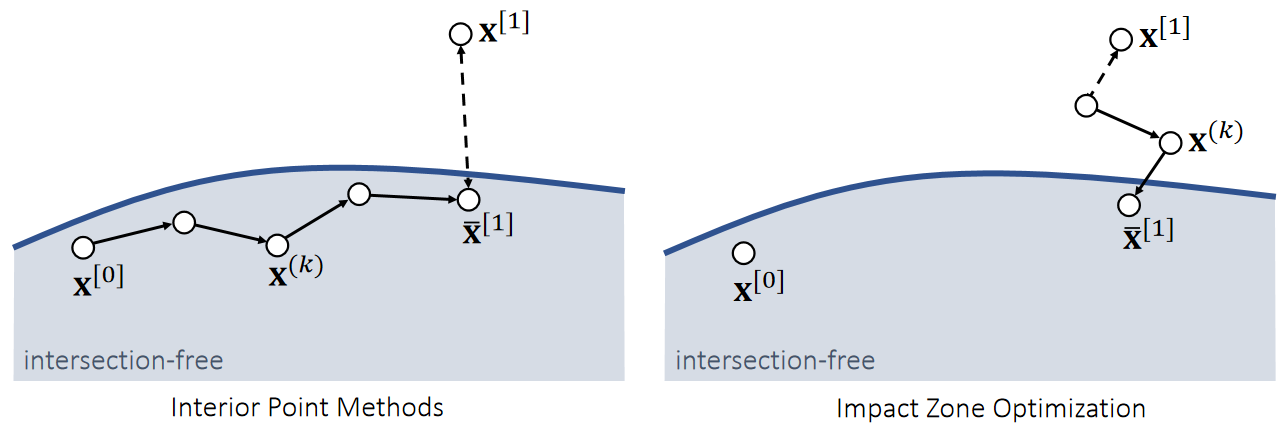
✅ 整个图代表刚体的状态空间而不是位置空间。
✅ 每个小圆点代表一个刚体状态,而不是一个粒子。
✅ \(\mathbf{x} \) 是刚体状态的表示符,至少包含质心的状态和旋转信息。
| 内点法 | Impact Zone 法 | ||
|---|---|---|---|
| ✅ 从\(\mathbf{x}^{[0]}\)出来,朝\(\mathbf{x}^{[1]}\)走,并永远保证只在安全区域走,直到不能走为止。 | ✅ 从\(\mathbf{x}^{[1]}\)出发,反复优化结果(投影),直到回到安全区域为止。 | ✅ 蓝色区域为安全区域 | |
| 优点 | Always succeed | Fast. 1. Close to solution. 2. Only vertices in collision (impact zones). 3. Can take large step sizes. | ✅ Impact Zone:1. \(\mathbf{x}^{[1]}\)通常离安全区域不太远,且优化时只针对 Impact Zone 优化,因此快。 2. 只有\(\mathbf{x}\)不在安全区域时才需要做。 ✅ 内点:哪怕\(\mathbf{\bar{x}}^{[1]}\)最终没有到最佳位置,但能保证一定在安全区域,因此一定成功。 |
| 局限性 | Slow. 1. Cautiously by small step sizes. 2. Far from solution. 3. All of the vertices. | May not succeed. | ✅ 内点:1. 为保证每一步安全,步长不能太大,因此慢。 2. \(\mathbf{x}^{[0]}\)和\(\mathbf{x}^{[1]}\)可能比较远,也导致慢。 3. 每一次都必须要做 |
P30
Log-Barrier Interior Point Methods
算法过程
For simplicity, let’s consider the Log-barrier repulsion between two vertices.
$$E(\mathbf{x} )=−\rho \text{ log} ||\mathbf{x} _{ij}||$$
$$ \mathbf{f} _i(\mathbf{x} )=−∇_iE=ρ\frac{\mathbf{x} _ {ij}}{||\mathbf{x} _ {ij}||^2} \\ \mathbf{f} _j(\mathbf{x} )=−∇_jE=−ρ\frac{\mathbf{x} _ {ij}}{||\mathbf{x} _{ij}||^2} $$
[TODO]
$$
\frac{\alpha ||\mathbf{x}|| }{\alpha \mathbf{x}} =\frac{\mathbf{x}^\mathbf{T} }{||\mathbf{x}||}
$$
✅ 用 Log 定义能量、前面某一节课讲过。距离 → 能量 → 斥力
❓ \(||\mathbf{x}_{ij}|| \) 的物理含义没有定义。可能是希望两个三角形之间穿透矩离。\( \mathbf{x}\) 代表两个刚体的状态。
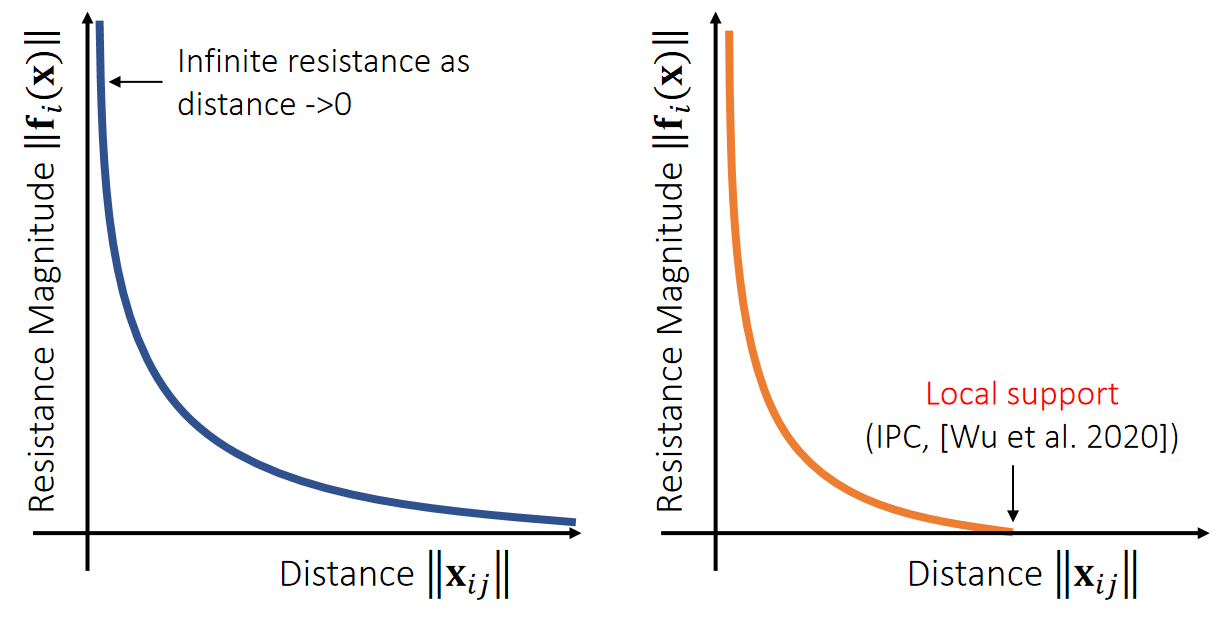
✅ 不需要互斥力一直存在,因此做了一个截断(IPC)
P31
算法实现
We can then formulate the problem as:
$$ \bar{\mathbf{x} }^ {[1]}\longleftarrow \mathrm{argmin} _\mathbf{x} (\frac{1}{2} ||\mathbf{x} −\mathbf{x} ^{[1]}||^2−ρ\sum \mathrm{log} ||\mathbf{x} _{ij}||) $$
✅ 优化目标:点的位置与目标位置(穿模)尽量接近,且不穿模。
✅ 绿色是来自\(\mathbf{x}^{[1]}\)的引力,对应公式第1页。黄色是来自边界的斥力对应公式第2页。
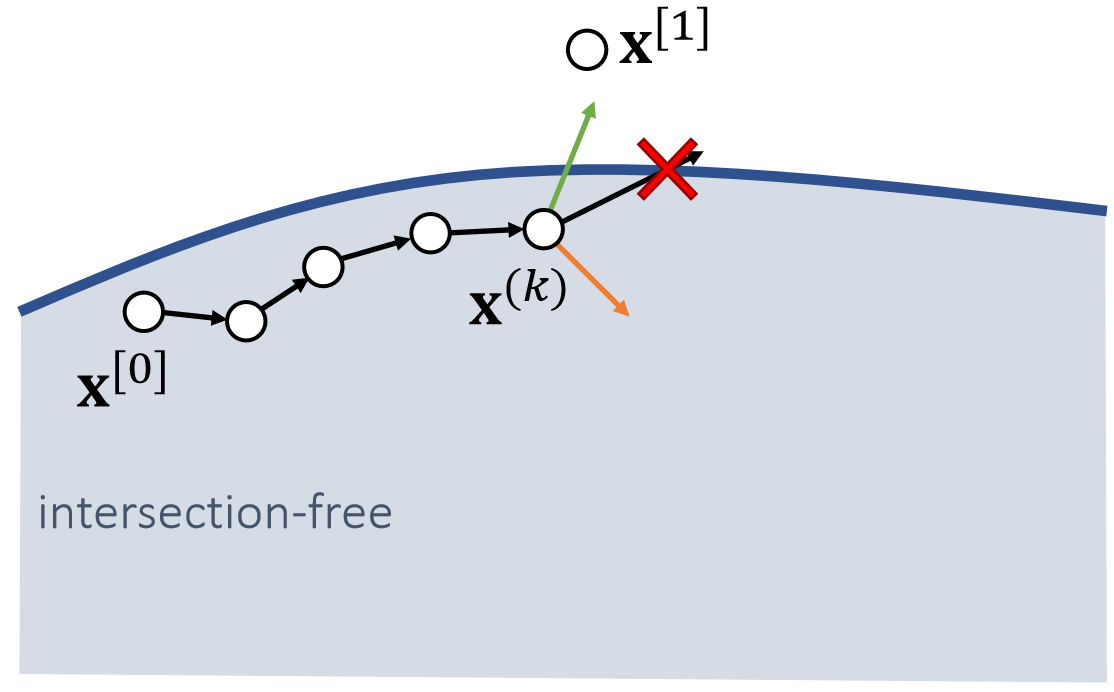
Gradient Descent:
\(\mathbf{x} ^{(0)}\longleftarrow \mathbf{x} ^{[0]}\)
For \(k=0…K\)
$$\mathbf{x} ^{(k+1)}\longleftarrow \mathbf{x} ^{(k)}+α(\mathbf{x} ^{[1]}−\mathbf{x} ^{(k)}+ρ\sum \frac{\mathbf{x} _{ij}}{||\mathbf{x} _{ij}||^2})$$ \(\bar{\mathbf{x} }^ {[1]}\longleftarrow \mathbf{x} ^{(k+1)}\)
✅ 每走一小步都需要反复的碰撞检测,重新计算\(||\mathbf{x} _{ij}||\)。
✅ 关键是步长\(\alpha \)
The step size \({\color{Red} α}\) must be adjusted to ensure that no collision happens on the way. To find \({\color{Red} α}\), we need collision tests.
[❓] \( \alpha \) 不是 learning rate 吗?为什么碰撞检测的结果会影响到\( \alpha \) ?
P32
Impact Zone Optimization
The goal of impact zone optimization is to optimize \(\mathbf{x}^{[1]}\) until it becomes intersection-free. (This potentially suffers from the tunneling issue, but it’s uncommon.)
tunneling issue 是指:\(\mathbf{x} ^{[1]}\) 离两个安全区都比较近。\(\mathbf{x} ^{[0]}\) 在其中一个安全区,而\(\mathbf{x} ^{[1]}\) 被优化到了另一个安全区。表现出的现象为穿透。
目标优化:
$$ \bar{\mathbf{x} }^{[1]}\longleftarrow \mathrm{argmin} _\mathbf{x} \frac{1}{2} ||\bar{\mathbf{x} }-\mathbf{x}^{[1]}||^2 $$
约束:
$$ \text{such that} \begin{cases} C(\mathbf{x} )=−(\mathbf{x} _3−b_0\mathbf{x} _0−b_1\mathbf{x} _1−b_2\mathbf{x} _1)\cdot \mathbf{N} ≤0 & \text{ For each detected vertex-triangle pair } \\ C(\mathbf{x} )=−(b_2\mathbf{x} _2+b_3\mathbf{x} _3−b_0\mathbf{x} _0−b_1\mathbf{x} _1)\cdot \mathbf{N}≤0 & \text{ For each detected edge-edge pair } \end{cases} $$

无约束优化问题
这是一个带约束优化问题。 Ⓐ
P36
We can then convert it into an unconstrained form:
$$\bar{\mathbf{x} } {[1]}\longleftarrow \text{argmin}_{x,λ}(\frac{1}{2} ||\mathbf{x} −\mathbf{x} ^{[1]}||^2+\frac{ρ}{2} ||\text{max}(\tilde{C} (\mathbf{x} ))||^2−\frac{1}{2ρ}||\mathbf{λ} ||^2) $$
$$ \tilde{C} (\mathbf{x})= \text{max}(\mathbf{C} (\mathbf{x} )+\mathbf{λ} /ρ) $$
Augmented Lagrangian:
\(\mathbf{x} ^{(0)} \longleftarrow \mathbf{x} ^{[0]}\)
\(\mathbf{λ \longleftarrow 0} \)
For \(k=0…K\)
$$\mathbf{x} ^{(k+1)} \longleftarrow \mathbf{x} ^{(k)}−α∇(\frac{1}{2} ||\mathbf{x} −\mathbf{x} ^{[1]}||^2+\frac{ρ}{2} ||\text{max}(\tilde{C} (\mathbf{x} ))||^2−\frac{1}{2ρ}||\mathbf{λ} ||^2)$$
\(λ\longleftarrow ρ\tilde{C} (\mathbf{x} )\)
\(\bar{\mathbf{x} } ^{[1]}\longleftarrow \mathbf{x} ^{(k+1)}\)
Tang et al. 2018. I-Cloth: Incremental Collision Handling for GPU-Based Interactive Cloth Simulation. TOG. (SIGGRAPH Asia)
P37
About Impact Zone Optimization
-
Fast per iteration
- Only have to deal with vertices in collision.
-
Convergence sensitive to \(||\mathbf{x} ^{[0]}−\mathbf{x} ^{[1]}||^2\), or the time step \(∆t\)
- Can take many iterations to, or never achieve intersection-free.
- Easy solution is to reduce \(∆t\), but that increases total costs.
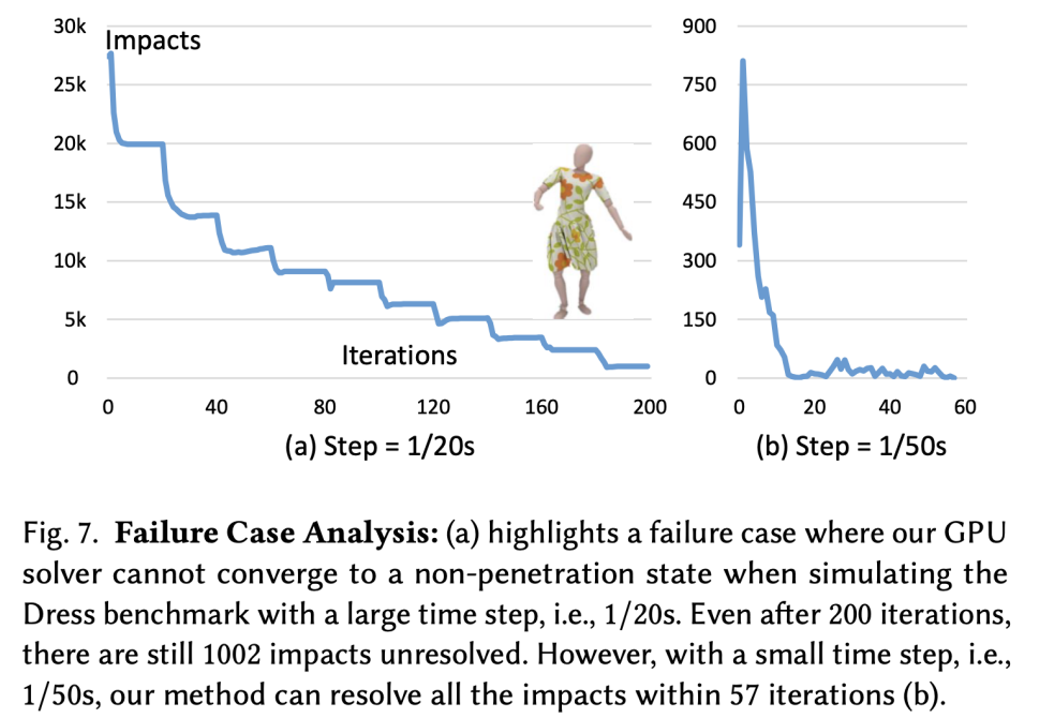
P33

Every pair gives new positions to the involved vertices. We can combine them together in a Jacobi, or Gauss-Seidel fashion, just like position-based dynamics.
P34
After-Class Reading (Cont.)
Bridson et al. 2002. Robust Treatment of Collisions, Contact and Friction for Cloth Animation. TOG (SIGGRAPH).
Relative simple explicit integration of cloth dynamics
P38
Rigid Impact Zones
The rigid impact zone method simply freezes vertices in collision from moving in their pre-collision state. It’s simple and safe, but has noticeable artifacts.

✅ 检测到碰撞,则把这个区域退回到上一帧。
P39
A Practical System Summary
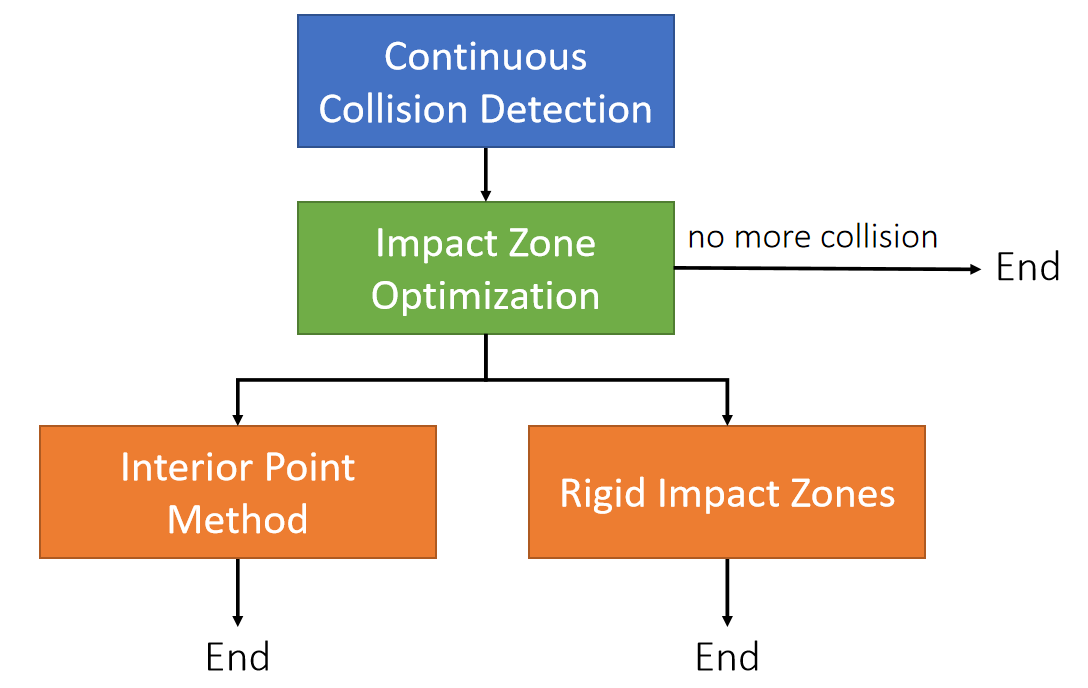
✅ 有碰撞,先做 Impact Zone. 因为这个快、不能解决再用后面方法、计算量不允许则选择 Rigid Impact.
本文出自CaterpillarStudyGroup,转载请注明出处。
https://caterpillarstudygroup.github.io/GAMES103_mdbook/